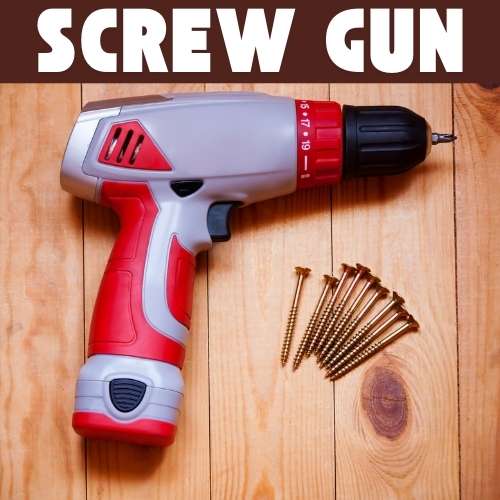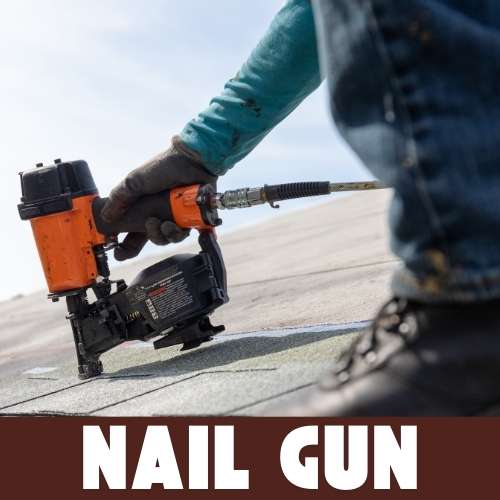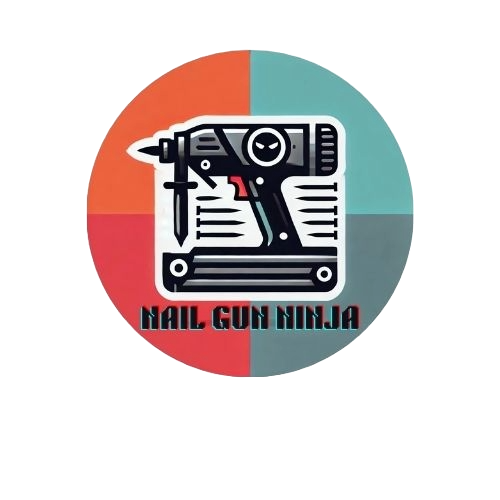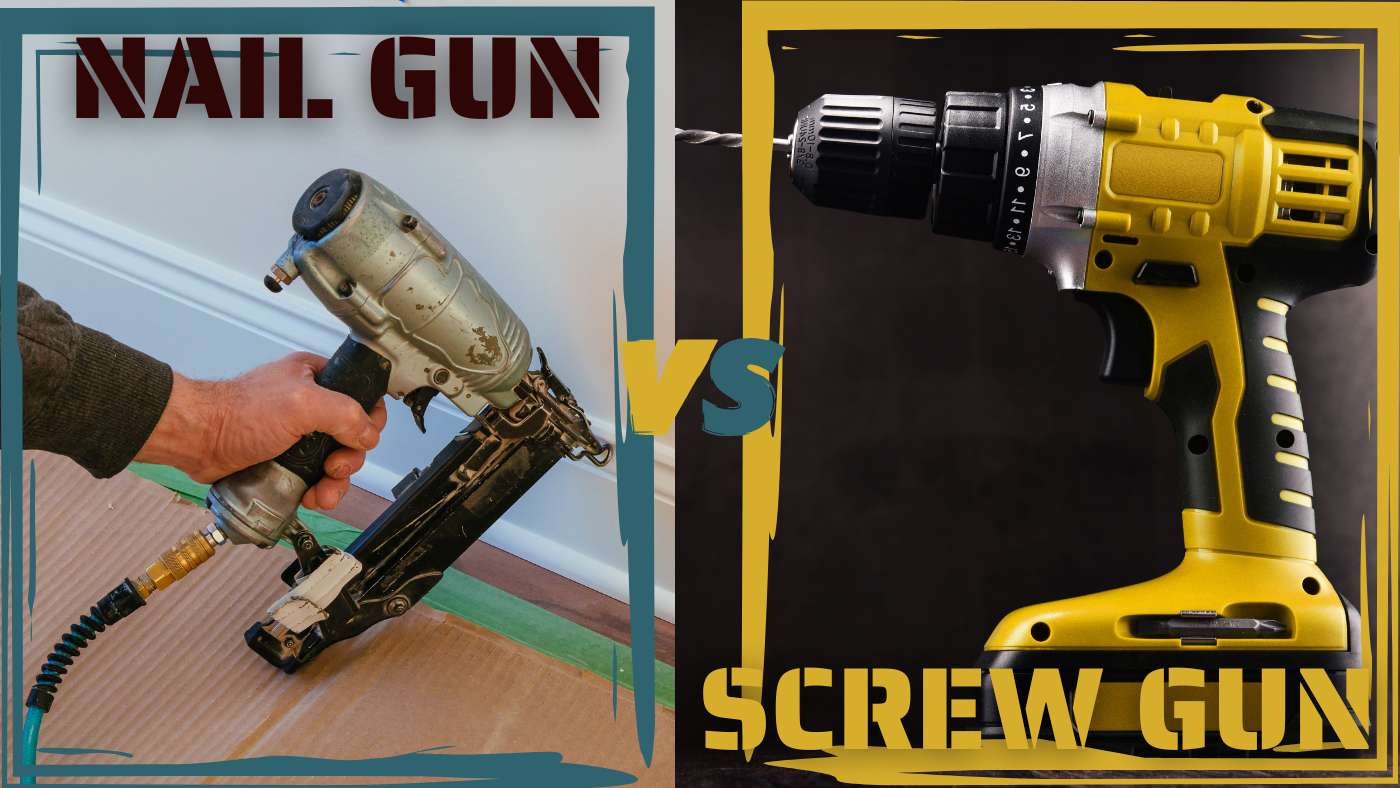Screw guns and nail guns are two commonly used fastening materials in the power tool industry. Both power tools make fastening jobs quicker and more efficient. You can’t think of starting a project without one of these tools.
These tools have different purposes and excel in specific jobs. Screw gun vs nail gun – is a big confusion among the users. Users often wonder which one to use for their next project.
If you learn about the core differences between these two options, it will be quite easy to determine which tool is perfect for your project.
What Is a Screw Gun?

A screw gun is a fastening tool designed to drive threaded screws quickly and efficiently. Screw guns look similar to drill machines. This gun is specifically made for fastening screws.
They have a special tip that holds screws safely. It makes them operate easily without losing grip. Screws guns also come with adjustable depth settings to ensure precise control. Some specific models or brands of screw guns have magazine attachment that feeds screws automatically.
Screw guns are popularly used in construction works, especially installing drywall or decking. This tool is very special for professionals and DIYers as it saves time and effort compared to a manual screwdriver.
What Is a Nail Gun?

A nail gun is a commonly used tool that drives nails into materials. Nail guns replace the need for hammers and makes the nailing process faster and more efficient.
Nail guns are operated by using force, from compressed air rechargeable batteries, to push nails into the surface. You need to insert the right size of nails into the nail gun magazine to make your project successful.
Nailer guns are mostly used in construction, woodworking, and home improvement projects. They have different versions like pneumatic, electric, battery-powered, and gas-powered.
Key Differences Between Screw Guns and Nail Guns
Nail guns vs screws – a big debate among the users. Let’s break down the core differences between these two mostly used tool:
Primary Purpose
Screw Gun: Screw guns are used to drive screws into materials. The screw gun uses threaded screws.
Nail Gun: Nail guns are designed to drive nails into materials like wood, metal, or concrete.
Holding Power
Screw Gun: Screws provide superior holding power as they use threaded screws. They are suitable for load-bearing applications.
Nail Gun: Nails depend on the natural resistance and friction of the materials for superior holding strength.
Speed and Efficiency
Screw Gun: Comparatively slower than nail guns. Screws need to be aligned into the material accurately. The process takes time.
Nail Gun: Fire nails faster and quicker than screw guns. The pneumatic version of nail guns is faster than other versions. They can drive nails in a fraction of a second.
Flexibility & Adjustability
Screw Gun: Screws can be removed, replaced, or adjusted without damaging the material’s surface. You can use screw guns if future modifications are required.
Nail Gun: Nails are more challenging and tough to remove from materials. It often causes damage to the material’s surface. They are better for permanent installations.
Tool Design and Features
Screw Gun: Comes with a nose piece for aligning screws. Adjustable depth settings determine how far the screws will penetrate. Some screw guns come with screw-loading magazines.
Nail Gun: Comes with various types like framing nailers, brad nailers, pin nailers, roofing nailers, etc. Each is designed with specific nail size compatibility. Gun nailers are equipped with safety functions.
Power Sources
Screw Gun: Mainly powered by electricity (corded) or batteries (cordless). Easily portable and efficient for long-time use.
Nail Gun: Portability depends on the versions. Pneumatic versions need air compressors and hoses to drive nails. Cordless versions need rechargeable Lithium-Ion batteries. Moreover, they come with electricity and gas-powered versions.
Safety Considerations
Screw gun: Screw guns are typically safer to operate. Screws are driven at a controlled speed with less injury risk.
Nail Gun: Requires careful handling as nailers drive nails high-speed. Sudden slip or accidental discharge will result in serious injuries.
Nails & Screws Size Comparison
Screw Gun: Screws are mainly measured by gauge and length. Gauge refers to the diameter of the screw. For example, a #10 screw is thicker than a #8 screw. In the United States, screw sizes are generally marked with a # (Hashtag). Length refers to the inch of screws. For example, ¼ inch, 6 inches.
Nail Gun: Nails are widely measured by a penny, which is abbreviated as “d”. Suppose, 16d nails, 8d nails. The length of common nails ranges from 2d (1 inch) to 60d (6 inches).
Learning Curve
Screw Gun: Easier to operate for beginners. Their operation is similar to drills and offers better control.
Nail Gun: Need more practice for beginners to handle safely. Especially, pneumatic nail guns are more powerful that need proper training and practice. Beginners can use cordless and lightweight nail guns.
Cost
Screw Gun: Generally less Expensive than nail guns. Basic corded drywall screw guns price range from $50 – $150. Cordless versions’ price range from $100 – $300 (Except Battery), and screw guns with advanced features price range from $200 – $400 or above.
Nail Gun: Pneumatic versions are quite expensive than other versions. Battery-operated nail guns come with less price. Air nail guns price range from $100 – $300 (Except Air Compressors). Cordless versions’ price range from $200 – $400 and above (Except Battery). High-end nail guns price range from $200 – $500 or above.
N:B: Price ranges are not exact. They may vary based on the market, brand, or models.
Maintenance
Screw Gun: Dust and debris removal is important, especially around the chuck. Regular inspection of the chuck. Keeping bits sharp and in good condition is crucial. Parts might be replaced occasionally. Minimum frequency of lubrication than nail guns.
Nail Gun: Need more emphasis on air system maintenance (for pneumatic models) and lubrication. nail magazine and nosepiece need to be cleaned. Nail guns should be dust and debris-free. Gun nails need more maintenance than screw guns.
Fastener Type
Screw Gun: Uses threaded screws to grip materials tightly and securely with a strong and durable bond.
Nail Gun: Drive nails. You should choose the right size of nails. Nails are more permanent than screws.
Noise Creation
Screw Gun: Screw guns create less noise than nail guns. They are generally quieter. Ideal for indoor work.
Nail Gun: Nail guns make a loud noise during work. Pneumatic models mainly create maximum noise.
Differences – At a Glance
| Category | Screw Gun | Nail Gun |
| Primary Purpose | Drive screws into materials | Drive nails into materials |
| Holding Power | Strong and durable grip because of threads | Depends on friction and compression |
| Speed and Efficiency | Slower | Much faster and quicker |
| Flexibility and Adjustability | Can be removed, replaced, or adjusted without damaging the material’s surface | Challenging and tough to remove from materials |
| Tool Design and Features | Comes with a nose piece for aligning screws. | Comes with various types. Each is designed with a specific nail size |
| Power Sources | Electric (corded) or battery-powered | Pneumatic, gas, electric, or battery-powered (cordless) |
| Safety Considerations | Safer because of controlled speed | High risk due to fast firing. Requires safety mechanisms |
| Nails and Screws Size | In the United States, screw sizes are generally marked with a # (Hashtag) | Nails are widely measured by a penny, which is abbreviated as “d” |
| Learning Curve | Easier to operate for beginners | Need more practice for beginners to handle safely |
| Cost | Less expensive | Higher cost |
| Maintenance | Less or occasional maintenance | Regular maintenance, and regular oiling of pneumatic models |
| Fastener Type | Threaded screws | Smooth or ridged shafts nail |
| Noise | Quieter than nail guns | Create loud noise |
Pros and Cons of Using a Screw Gun
Let’s explore the pros and cons of screw guns:
| Pros | Cons |
| Fast for repetitive tasks such as drywall | Slower compared to nail guns |
| Adjustable settings ensure consistency | Requires time to deliver optimal depth settings |
| Provides excellent control | Imperfect for heavy-duty or large-scale jobs |
| Beginner-friendly | Bulkier than manual screwdrivers |
Pros and Cons of Using Nailing Guns
Let’s explore the pros and cons of nailer guns:
| Pros | Cons |
| Consistent nail depth | Tough to adjust nails without damage |
| Various types (framing, finish, brad, pin, etc.) | Needs specific nail types and sizes |
| Reduces physical strain | Might be bulkier and heavier |
| Ensure ergonomic grip to reduce hand fatigue | High risk of accident and injuries if mishandled |
How to Choose Between a Screw Gun and a Nail Gun?
If you get confused about which tool to choose for your project, do not need to be worried. Whenever you step into selecting a nail gun or screw gun, you should consider the project type and the material type you are going to work on.
If you assess the project type and material type successfully then, it will be quite easy to choose the best-suited tool.
Here, I have tried to show which type of tool you need to choose based on the project type and material type. I hope it will be helpful for you.
Consider the Project Type
| Project | Pick up a Screw Gun | Pick up a Nail Gun |
| Drywall Installation | ✅ Offers precise depth control | ❌ Not appropriate for drywall |
| Structural or Framing Projects | ❌ Too slow and less holding strength | ✅ Perfect for framing related works |
| Furniture Assembly | ✅ Precise and adjustable | ❌ May damage materials’ surface |
| Decking and Flooring | ✅ Provide strong bond and screws are removable | ✅ Quicker installation for subfloors |
| Roofing and Siding | ❌ Not suitable | ✅ Suitable for high-speed fastening |
| Trim and Molding | ❌ Too slow for decorative works | ✅ Delivers a clean and professional output |
| Cabinet Installing | ✅ Perfect for assembling cabinets and securing shelves | ❌ Nails might be used, but screws are better because of precision in this case. |
| Fencing | ❌ Not the best tool for this task. It is a large task, Screws are slower for larger tasks | ✅ Fastens pickets and boards quickly. Go for framing nail guns |
| Railings | ✅ For attaching posts and stair railings | ❌ May not provide the level of precision required |
| Construction of Pallet | ✅ In this type of project, screws provide more durability. | ✅ Can be used for quick assembly. |
| Door and Window Trimming | ✅ Offers a strong bond when attaching decorative trim around doors and windows. | ✅ Faster and good for trimming work. |
| Concrete Formwork | ✅ Screws are better for temporary holding of formwork. | ❌ Nailer guns are not best for fastening concrete forms. |
| Plywood Sheathing | ✅ Secure fastening for structural sheathing on walls and roofs. | ✅ Nails are faster, though they aren’t secure for the long term. |
| Furniture Repairing | ✅ Perfect for repairing wooden furniture | ❌ Nails could damage the wood, but you can use them. |
| Wall Panels | ✅ Attaching wooden panels | ✅ Work well for quick wall panel installation |
Consider the Material Type
| Material Type | Use Screw Guns | Use Nail Guns |
| Drywall | ✅ Screws are better. | ❌ Not ideal, may overkill or damage the drywall. |
| Wood | ✅ Can assemble wooden parts. | ✅ Fastens wood efficiently. |
| Metal | ✅ Self-tapping screws | ❌ Not perfect |
| Concrete or Masonry | ❌ Not powerful | ✅ Specialized nail guns are ideal. |
| Plaster | ✅ Screw guns with long screws. | ❌ Nail guns are not ideal. |
| PVC | ✅ Long-lasting fastening of PVC pipes and panels. | ❌ Nails may not be ideal for PVC. |
| Softwood (Pine, Cedar) | ✅ Provides accurate fastening. | ✅ Fastens efficiently and precisely. |
| Hardwood (Oak, Maple) | ✅ Screws work on hardwoods and provide better stability. | ✅ Nails can be applied for faster work. |
| MDF (Medium-Density Fiberboard) | ✅ Perfect for securing MDF panels without splitting. | ❌ Nail guns can damage the thinner panels. |
| OSB (Oriented Strand Board) | ✅ Offers a stronger bond when working with OSB materials. | ✅ Use for quick fastening for sheathing with OSB. |
| Brick | ✅ screw guns are used for fixing into brick when using masonry screws. | ❌ Nail guns are not perfect for masonry or brick applications. |
| Fiberglass | ✅ Perfect for attaching fiberglass panels. | ❌ Nail guns may crack fiberglass panels. |
| Glass | ✅ Apply specialized screw guns. | ❌ Nail guns are not suitable. |
| Rubber | ✅ Use screws to secure rubber sheeting. | ❌ Nail gun nails might puncture rubber materials. |
| Insulation Boards | ✅ Screws with large washers are ideal for insulation materials. | ✅ Nails can be used but may not provide strong hold as screws. |
From the above statement, we can assess which type of tool we need to choose. In some projects and materials nail guns are the best option. And some cases screw guns are the perfect option.
Moreover, in the case of some projects and materials nail guns or screw guns both are applicable. It means in that case you can choose either a nail gun or a screw gun. But, indeed, you can’t utilize both tools at the same time.
My Final Words
So far we have discussed nail guns and screw guns. Here we have learned some big and subtle differences between these fastening tools. Choose either a nail gun or a screw gun. But before choosing learn their differences to make your project successful.
FAQs
1. Is it better to use a nail gun or screws?
Ans: Both tools are better. But it is wise to use nailer guns or screws based on the project type, and material type.
2. Can You Replace a Nailer Gun with a Screw Gun?
Ans: No, you can not replace a nailer gun with a screw gun directly. They are specifically featured for different purposes. If you have any project that requires both tools, then you may combine them. But remember, you can never use them at the same time and can’t replace them directly.

